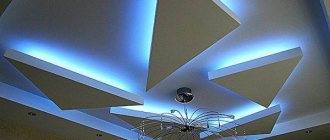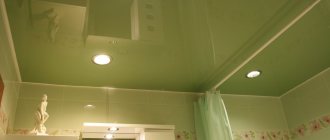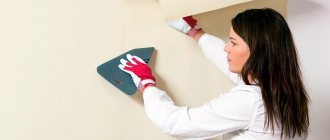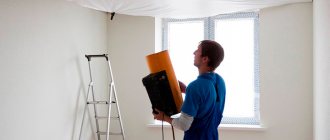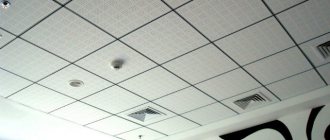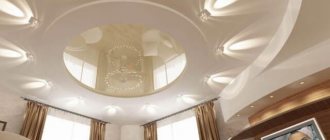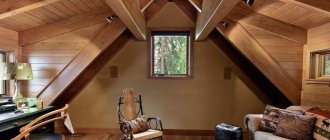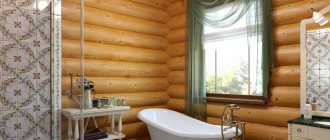Every home owner dreams of having a perfectly flat ceiling, so many people choose tension structures. The stretched fabric will hide any surface imperfections and will look better than many finishing materials. But after the entire structure is installed, a gap becomes noticeable between the edge of the ceiling and the wall. To hide it, you need to install masking tape. But why should you choose it and not a standard ceiling plinth?
Purpose of masking tape
The appearance of a gap along the walls after installing a stretch ceiling is not a miscalculation or an error in measurements. The thing is that the tension fabric is not mounted directly on the wall, but on a pre-installed profile. The profile has a cavity into which, during installation of the ceiling, a rigid edging of the tension fabric is inserted with a special spatula. The tensioned fabric is fixed tightly to the edge of the profile that is closer to the center of the ceiling surface, and the resulting technological hole in the profile itself remains open, so it needs to be closed.
In order to hide this gap, the construction industry offers several different options. As a rule, for this purpose, canvas installers use a special masking tape for suspended ceilings. But, as an option, depending on the design of the room, a wide molding or a beautiful ceiling cornice, additionally decorated with LED lighting, can also be used.
How is it different from usual?
You cannot glue anything to a thin fabric. Therefore, the plinth for a stretch ceiling should be quite light, because it will only be attached to the wall.
It is also worth paying attention to the shape. It should be such that the wider part is adjacent to the wall. This way the fixation will be more reliable.
One more nuance needs to be taken into account; many people confuse a regular baseboard with a camouflage insert. And these are two completely different things.
Regular moldings can be used with any ceiling, and inserts can only be used with a tension ceiling. They have a special T-shape to be inserted into the profile groove on which the blade is held.
Quality characteristics of masking tape
Designed to provide a finishing touch, masking tape for stretch ceilings is a narrow and soft profile. It is made, like the canvas itself, from PVC material. The texture of the material is very flexible, so it is easy to bend, but it will not break or deform, which makes it possible to use it on the most curved structures. Installers also call masking tape a plug for suspended ceilings.
The plug for suspended ceilings has many positive qualities, among them:
- the ability to hide the gap along the wall that remains after the suspended ceiling is completely installed;
- flexibility and plasticity will allow you to design any rounded corners of the room;
- in large spacious rooms where the ceiling area is large, it is used as a connection between two canvases;
- selected in different colors, can serve as decoration for a multi-level structure;
- thanks to a fairly wide range of colors, it can be matched to any type and shade of coating, while the correct choice of color scheme will help it be organic, invisible or, conversely, brightly frame the perimeter of the ceiling;
- the properties of the manufacturing material do not allow it to deform regardless of its service life;
- in case of ceiling replacement, can be reused;
- the material is resistant to various chemicals, so glue or paint will not have any destructive effect;
- ease of installation does not require special knowledge and skills, only some effort is required;
- due to the strength of the material, it does not deteriorate during operation and does not lose its qualities;
- It can be purchased by footage of any length, which allows you to minimize the number of joints;
- in small rooms, the advantage of such a device is that it does not take up extra space, unlike ceiling plinths;
- prevents the accumulation of dust that could get into the gap near the wall;
- An important advantage is the relatively low price.
Masking tape also has some disadvantages, mainly related to interior design:
- firstly, it will not be able to hide very obvious defects and unevenness of the walls at the ceiling level;
- secondly, when using tape it is not possible to install lighting, therefore, if the need arises, the problem can be solved with the help of a special ceiling cornice.
What to choose?
To understand where we should focus, let's bring our competitors together in a fair fight and consider their advantages and disadvantages.
Ribbon
- First and foremost: decorative tape for suspended ceilings is mounted reversibly. Situations when a suspended ceiling has to be dismantled are not as rare as it might seem.
The list of reasons includes faulty hidden communications, replacement of pipes (including heating risers in rooms), short circuits and other wiring problems, flooding from above... In short, sooner or later the ceiling may need to be removed and reinstalled.
The harpoon method of fastening allows you to do this without any problems. The tape is easy to pull out of the profile and then insert into place. But the glued plinth will have to be torn off and thrown away.
Sometimes a suspended ceiling requires dismantling. At least to drain the water.
- The tape is much narrower than the ceiling plinth. Even if you choose a contrasting color, it will reduce the visible ceiling area very slightly. But it is by the area of the floor and ceiling that human vision estimates the size of the room.
- The advantage of the tape is also the disadvantage of the plinth against its background: dismantling the ceiling means that the plinth will have to be cut off and... thrown away. The area for the sticker will no longer be smooth.
- But the large width of the plinth is not always a disadvantage. It can hide a much wider gap and disguise significant irregularities.
Skirting
Advice: where the walls have minor depressions, the plinth does not follow its shape, but is glued with a gap, which is then puttied (see Gypsum ceiling plinth: installation instructions).
- The main advantage of the ceiling plinth has already been mentioned: it allows you to make the ceiling illuminated from below. At the same time, the room is visually made much higher (see How to choose a ceiling plinth: material, color and shape).
Mount the ceiling plinth just below the ceiling, place lighting in it - and the room will be transformed.
Advantages of masking tape over ceiling plinth
The main task performed by masking tape is to decorate the gap between the tension fabric and the wall. But there is another way of masking the joint that deserves due attention - this is a ceiling plinth. If you have decided on a choice in favor of a plinth, then you need to familiarize yourself with the features of its installation.
The plinth is mounted directly to the wall. Under no circumstances should it be glued to a tension fabric, because it can wave from its weight, and a draft that vibrates the film will loosen the adhesive seam of the baseboard. Moreover, it is unknown how the canvas material will react to the chemical composition of the glue.
In the event that a plinth will be used to complete the installation of a suspended ceiling, then experienced specialists advise using one that has the maximum width of the area, due to the fact that the sticker will be carried out only on one surface, on the wall, and due to the width it will be more reliable hold on.
A negative aspect of its use is the fact that, in the case of replacing a stretch ceiling, the owner is faced with some problem. The plinth must be dismantled, and it cannot be reused, so it is thrown away, and the surface of the walls where it was glued must be leveled. Accordingly, the presence of baseboards in the structure also complicates possible repairs of the stretch ceiling. It can be fully replaced with a wide molding, then problems with the sticker will be reduced, because the molding was originally intended for attachment to the wall.
In general, the ceiling plinth fits perfectly with the suspended ceiling, if not for its specific installation. But, masking tape has one special advantage. Once dismantled during operation, it is subject to subsequent installation without loss of appearance and inherent qualities.
Is it necessary?
The answer to the question of whether a plinth is needed depends on the type of ceiling installed.
If we are talking about PVC film, then yes, a baguette is necessary. Because such fabrics are stretched in three ways: harpoon, wedge and glazing bead.
In all cases, a gap of about 0.5 cm is formed along the perimeter between the wall and the film. This looks unaesthetic, so it is covered with a plinth or a special decorative insert.
If we are talking about fabric stretch ceilings, then they are inserted into a special clothespin profile. In this case, there are no gaps left, and there is no urgent need for a plinth. If desired, you can not install it.
Types of masking tapes
Masking tapes or plugs, depending on their shape, received certain names.
1. T-shaped.
This type is made from rigid polyvinyl chloride. Because of its texture, it is most often used to decorate cracks on smooth wall surfaces, such as tiles and porcelain stoneware.
2. L-shaped.
For the manufacture of L-shaped or L-shaped tape, polyvinyl chloride of a soft and elastic structure is used. The flexible texture does an excellent job of masking gaps near walls that have obvious and noticeable irregularities. The superelasticity, flexibility and strength of the L-shaped wall plug is widely used in plasterboard structures to mask transitions in multi-level ceiling structures with complex curved shapes.
The universal L-shaped plug has the fastest and easiest installation. But, there is some nuance that experienced installers warn about. When using this type for a plastic profile, its installation is a little problematic, because due to its geometric shape, it does not have a rigid fixation with the wall, and over time it creates the impression of uneven walls. It’s another matter when an aluminum baguette is used, which itself has a rigid attachment to the wall. In such a baguette, installation of an L-shaped plug is difficult, but it is installed rigidly and evenly, and over time it does not lose its shape.
3. F - shaped.
PVC tape is mainly used when the ceiling area is large and one sheet is not enough to decorate the ceiling surface with a stretch ceiling. Then it is used in profiles connecting two sections of ceiling covering. This plug is perfect for both plastic and aluminum profiles, forming an ideal and even plane with the canvas.
When purchasing masking tape, it is necessary to take into account information from the manufacturer, because only products made from high-quality material do not have a strong rubber smell and will be able to perfectly perform their function.
Recommendations for choosing color and texture
Manufacturers of masking tapes offer a sufficient selection of colors and textures.
The main types of invoices include:
- Glossy masking tapes serve mainly as decoration for glossy canvases. They perfectly reflect light, which is advantageously used in combination with selected lighting when decorating interiors.
- The matte texture will serve as an excellent continuation for stretched matte canvases.
- Patterns and embossing make it an additional decorative element for decorating the interior style of the room.
Great importance for maintaining the interior style is given to the color of the tape used, for example:
- a plug of one tone with a suspended ceiling contributes to the visual expansion of the room, a contrasting shade, on the contrary, will make the room narrower;
- if you take a tape that matches the tone of the walls, the walls will appear higher than they actually are;
- contrasting shades of the plug will draw a clear line between the ceiling surface and the walls, which, in this case, must be perfectly smooth, because otherwise, the contrast will only draw attention to unevenness;
- An interesting option for combining the color of the ribbon with the color of furniture or other interior decoration elements.
You can paint the tape yourself with any acrylic paint, but this must be done before installing it.
Thanks to the wide range of colors, it can easily be matched to a wide variety of stretch fabrics. A variety of shades, ranging from white to black, are used for both matte and glossy and patterned masking tapes.
Modern ceiling design involves not just colored canvases, but the use of color photo printing, which makes the interior very individual and especially beautiful, and masking tape will only enhance this effect.
Pros and cons of the alternative option
To understand how effective such options for sealing gaps between the wall and the ceiling sheet are, let’s analyze the strengths and weaknesses of the alternative option.
Among the advantages:
- no special tools are needed to close gaps;
- do not visually make the room smaller, so they are suitable for small rooms;
- The plug can be easily removed. There are also no obstacles to removing the decorative cord, although the process is more labor-intensive;
- both the plug and the decorative tape can be easily matched in color to the interior of the room;
- high elasticity allows you to design curved sections of walls;
- resistance to high humidity (can be installed in the bathroom);
- easy care.
Minuses:
- decorative cord collects dust, which requires frequent maintenance;
- wide gaps are difficult to hide;
- the cord emphasizes significant unevenness of the wall;
- fillets look more interesting in the interior.
Conclusion: if it is not possible to fix baguettes on the walls, plugs and decorative cords are an almost ideal replacement option.
Installing masking tape
The process of installing masking tape is quite simple and does not require much time, special knowledge and skills, or special equipment. A decorative masking tape is inserted into the gap formed between the ceiling tension fabric and the wall, or rather, into the free part of the cavity of the profile fixed to the wall, using a slight pressure. Installation of masking tape for a stretch ceiling occurs without the use of glue, sealant or other fixing agents, which allows you to freely dismantle it, if necessary.
If there is no experience appropriate for this work, then experts recommend doing this work without using any tools, such as a spatula, screwdriver or other hard object, so as not to damage the tape or tension fabric, or the wall covering.
Depending on the type of tape, the installation process is no different. Step by step it looks like this:
Step 1. You need to measure and cut the required length of masking tape. Measurements must be taken carefully to avoid the appearance of unnecessary joints and cracks, which will require additional sealing and may subsequently be visible.
Step 2. To accurately connect two pieces of tape, measure the angle of the joint, which is cut using a miter box and a knife. From an aesthetic point of view, it is better to make connections in the corners of the room. To make it as even as possible, you need to mount the tape at an angle slightly less than 90º.
Step 3. Installation should begin from the corner of the room. Using gentle movements and gentle pressure, the tape is inserted into the slot near the wall.
Step 4. The tape inserted by pressing along the entire perimeter of the room means the end of the final stage of installing the stretch ceiling.
After the tape masking the gap is inserted, the ceiling space takes on a finished look. A huge advantage in using masking tape is that it is equally easy to remove and put back in, and at the same time it does not lose its appearance or its qualities. You just need to pry it off with a screwdriver, after which it can be easily removed. Dismantling the ceiling can be for various reasons: replacing the canvas, flooding from above, repairing communications running under the ceiling, and the first action will be removing the tape.
